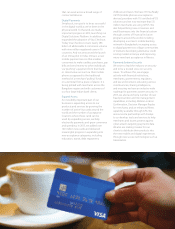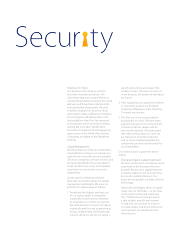Visa 2015 Annual Report Download - page 19
Download and view the complete annual report
Please find page 19 of the 2015 Visa annual report below. You can navigate through the pages in the report by either clicking on the pages listed below, or by using the keyword search tool below to find specific information within the annual report.
iii. New platforms, products and services. Visa continues to develop new platforms, products
and services to benefit clients, merchants, consumers and other partners.
a. Bangalore Technology Center: We are investing in internal technology resources
and have recently opened a new technology development center in Bangalore,
India that will play a central role in the Company’s efforts to accelerate digital
commerce globally. The new technology center, a combination of office and
collaboration space for more than 1,000 Visa developers, is Visa’s largest outside
the U.S.
b. Visa Checkout: Visa Checkout is a fast, simple and intuitive payment experience
that allows consumers to pay for goods online on a smartphone, tablet, laptop or
desktop, in just a few clicks. This service is presently available for eCommerce
merchants and financial institutions in 16 countries around the world including
Australia, Argentina, Brazil, Canada, Chile, China, Colombia, Hong Kong,
Malaysia, Mexico, New Zealand, Peru, Singapore, South Africa, United Arab
Emirates, and the U.S.
c. Visa payWave: With Visa payWave technology, consumers are able to pay for
products and services via smart phone or other devices, and by using their
contactless cards at physical retailers.
d. Visa Direct: Visa Direct provides a fast, secure and convenient solution for Visa’s
ecosystem of clients and partners. It enables customers to send and receive
person-to-person payments and funds disbursements, and facilitates business to
business settlements directly to eligible Visa account holders quickly and securely.
e. mVisa: In August 2015, Visa and several banks in India launched a pilot program
testing mVisa, a mobile application, in India. The service extends the utility of
existing Visa accounts by linking a consumer’s Visa debit, credit or prepaid
accounts to the mVisa mobile application that enables purchases in store, online
and person-to-person through his or her mobile device.
•U.S. Regulation. Rules were implemented in the U.S. during 2011 and 2012 with respect to
debit products under the Dodd-Frank Wall Street Reform and Consumer Protection Act (the
“Dodd-Frank Act”), which regulates, among other things, debit interchange reimbursements
rates, the availability of debit networks on a debit card and merchant transaction routing
choice. The Federal Reserve’s interpretation of the debit interchange provisions of the Dodd-
Frank Act was upheld in March 2014 by the Court of Appeals for the D.C. Circuit. After the
Supreme Court declined to review the ruling, the Federal Reserve on August 10, 2015
confirmed its position on the sole remaining issue related to the interchange cost calculation,
leaving the debit interchange rules in effect as originally adopted. See Government
Regulation below.
•Fiscal 2015 developments in Russia. In response to U.S. and EU sanctions targeting
Russia’s financial sector, the Russian government modified its National Payments Systems
laws to require that all payment transactions in the Russian Federation be processed within
the country. We agreed in February 2015 to transfer processing of Russian domestic
transactions to the government-owned processor. Additionally, a new Russian law requiring
all personal data of its citizens to be stored in Russia went into effect on September 1, 2015.
Authorities have also indicated that Russia will issue a new national payment card called the
“MIR” card. See Government Regulation—Government-imposed market participation
influences and restrictions below.
6
























